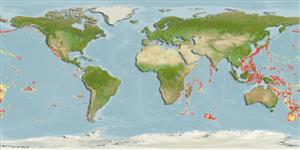Teleostei (teleosts) >
Ophidiiformes (Cusk eels) >
Ophidiidae (Cusk-eels) > Neobythitinae
Etymology: Luciobrotula: Latin, lucius = pike + Latin, brotula, -ae = little, bud, shoot (Ref. 45335).
More on authors: Smith & Radcliffe.
Environment: milieu / climate zone / depth range / distribution range
Ecology
Marine; benthopelagic; depth range 250 - 1185 m (Ref. 56809). Deep-water
Indo-Pacific: Gulf of Aden and Natal, South Africa to the Philippines, Japan and Hawaii.
Size / Weight / Age
Maturity: Lm ? range ? - ? cm
Max length : 45.0 cm TL male/unsexed; (Ref. 4103)
Dorsal
spines
(total): 0;
Dorsal
soft rays
(total): 87-94;
Anal
spines: 0;
Anal
soft rays: 69 - 75;
Vertebrae: 53 - 55. This species is characterized by the following set of characters: a relatively long lateral line ending below dorsal fin rays 19-26; dorsal fin rays 87-94, anal fin rays 69-75, precaudal vertebrae 15-16, total vertebrae 53-55 and total number of rakers on anterior gill arch 15-17 (3 long and 12-14 plates); longest gill raker 2.2-2.7% SL and snout to end of lateral line 48.0-56% SL; interorbital pore 1 and occipital pores 4 (Ref. 83453).
Benthopelagic at bathyal depth (Ref. 56809). Benthic (Ref. 58302). Shallowest depth range at about 250 m (Ref. 95664). Rare species (Ref. 34024). Reproductive strategy possibly similar to other members of this family featuring oviparity, with oval pelagic eggs floating in a gelatinous mass (Ref. 205).
Life cycle and mating behavior
Maturity | Reproduction | Spawning | Eggs | Fecundity | Larvae
Nielsen, J.G., 2009. A revision of the bathyal genus Luciobrotula (Teleostei, Ophidiidae) with two new species. Galathea Report 22:141-156. (Ref. 83453)
IUCN Red List Status (Ref. 130435)
Threat to humans
Harmless
Human uses
Fisheries: of no interest
More information
Common namesSynonymsMetabolismPredatorsEcotoxicologyReproductionMaturitySpawningSpawning aggregationFecundityEggsEgg development
ReferencesAquacultureAquaculture profileStrainsGeneticsElectrophoresesHeritabilityDiseasesProcessingNutrientsMass conversion
Tools
Special reports
Download XML
Internet sources
Estimates based on models
Preferred temperature (Ref.
123201): 2.1 - 10.8, mean 7.9 °C (based on 460 cells).
Phylogenetic diversity index (Ref.
82804): PD
50 = 0.5156 [Uniqueness, from 0.5 = low to 2.0 = high].
Bayesian length-weight: a=0.00380 (0.00174 - 0.00830), b=3.15 (2.95 - 3.35), in cm total length, based on LWR estimates for this species & (Sub)family-body (Ref.
93245).
Trophic level (Ref.
69278): 3.6 ±0.6 se; based on size and trophs of closest relatives
Resilience (Ref.
120179): Medium, minimum population doubling time 1.4 - 4.4 years (Preliminary K or Fecundity.).
Fishing Vulnerability (Ref.
59153): Low to moderate vulnerability (35 of 100).
